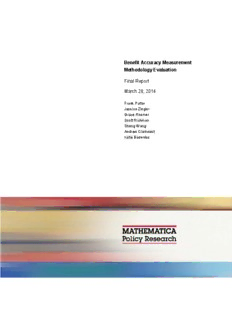
Benefit Accuracy Measurement Methodology Evaluation: Final Report PDF
Preview Benefit Accuracy Measurement Methodology Evaluation: Final Report
Benefit Accuracy Measurement Methodology Evaluation Final Report March 28, 2014 Frank Potter Jessica Ziegler Grace Roemer Scott Richman Sheng Wang Andrew Clarkwest Katie Bodenlos This page has been left blank for double-sided copying. Contract Number: Benefit Accuracy Measurement DOLQ121A21806/DOLU121A21967 Methodology Evaluation Mathematica Reference Number: 40155.800 Final Report Submitted to: March 28, 2014 U.S. Department of Labor Employment & Training Administration 200 Constitution Ave., NW Frank Potter Washington, DC 20210 Jessica Ziegler Project Officer: Andy Spisak Grace Roemer Scott Richman Submitted by: Mathematica Policy Research Sheng Wang P.O. Box 2393 Andrew Clarkwest Princeton, NJ 08543-2393 Katie Bodenlos Telephone: (609) 799-3535 Facsimile: (609) 799-0005 Project Director: Grace Roemer This page has been left blank for double-sided copying. ACKNOWLEDGEMENTS The study team would like to thank the many people who contributed to the development of this report. We truly appreciate all of their efforts. Most important, this study would not have been possible without the patience and generosity of the state unemployment insurance agencies and BAM units that participated in the study’s eight site visits and took the time to share their experiences with us. A number of staff at the U.S. Department of Labor (DOL) provided valuable input and guidance throughout the duration of this study. We especially appreciate the support and advice offered by Andy Spisak and Dennis Austin, the DOL project officers; Subri Raman, Chief, Office of Unemployment Insurance, Division of Performance Management; and Gay Gilbert, UI Administrator. Finally, we thank our numerous colleagues at Mathematica Policy Research, whose assiduous analysis, writing, reviewing, and editing were essential and appreciated. iii This page has been left blank for double-sided copying. ABSTRACT Errors in Federal–State Unemployment Insurance (UI) program payments have long been a concern to the U. S. Department of Labor (DOL) and other stakeholders. To maintain program solvency and public support for the program, it is crucial that payments are made only to eligible recipients and that payment amounts are correct. Since 1987, the U. S. Department of Labor (DOL) has assessed the accuracy of state UI program payments through the Benefit Accuracy Measurement (BAM) program, identified causes of improper payments, and initiated corrective action plans when systemic errors are found. Since 2002, DOL has also used BAM program data to generate UI program performance measures in compliance with the Improper Payments Information Act (IPIA) and its amendments—the Improper Payments Elimination and Recovery Act of 2010 (IPERA) and the Improper Payments Elimination and Recovery Improvement Act of 2012 (IPERIA)—and to produce several other program integrity rates. Given their role in gauging payment propriety and producing program performance measures in compliance with federal law, it is critical that BAM program data are comprehensive and accurate. Therefore, DOL contracted with Mathematica Policy Research to conduct a thorough review of existing BAM procedures and recommend improvements when necessary. This report documents findings from site visits to eight state UI agencies and analyses of BAM program data, proposes recommendations for redesigning aspects of the BAM program, and suggests alternatives to existing program integrity measures. v This page has been left blank for double-sided copying. CONTENTS I INTRODUCTION AND SUMMARY OF RECOMMENDATIONS ...................... 1 A. The BAM Program ..................................................................................... 2 B. The BAM Methodology Evaluation Research Questions and Data Sources ............................................................................................. 3 C. Summary of Recommendations for BAM Program Improvement .............. 5 II CHANGES TO BAM SAMPLE SIZES .............................................................. 9 A. Current Sample Size Approach ................................................................. 9 B. Recommended Approach: Samples Based on BAM Improper Payment Rates ........................................................................................ 11 1. Sample Size Requirements for the BAM Improper Payment Rates ................................................................................................. 12 2. Preliminary Sample Sizes for States ................................................. 15 C. An Additional Consideration: Sample Sizes Proportionate to UI Caseloads ................................................................................................ 18 III INTEGRATING TEMPORARY AND EPISODIC PROGRAMS INTO BAM ............................................................................................................... 21 A. States’ Concerns About the Feasibility of Integrating Temporary and Episodic Programs into BAM ............................................................ 22 B. Suggested Sample Design ...................................................................... 22 C. Implementation Considerations ............................................................... 24 IV IMPROVEMENTS TO BAM DATA COLLECTION ......................................... 27 A. BAM Claimant Questionnaires and DCI Redesign ................................... 27 1. Existing Questionnaire and Coding Procedures ................................ 27 2. States’ Perspectives on the Existing Questionnaire, DCI, and Coding Procedures ..................................................................... 29 3. Redesign Approach ........................................................................... 31 4. Redesigned Questionnaire ................................................................ 33 5. Improvements to the DCI and Coding Procedures ............................ 36 B. Design Considerations for a BAM Web Portal ......................................... 38 1. Purpose and Advantages .................................................................. 38 2. Design Considerations and Challenges ............................................ 40 3. Options for Web-Based Employer Reporting ..................................... 42 vii Contents Mathematica Policy Research V INTEGRITY RATE IMPROVEMENTS ............................................................ 43 A. Program Integrity Rates and Performance Measures that Rely on BAM Data ........................................................................................... 43 B. States’ Perspectives on the Rates and Measures ................................... 44 1. State Work Search and ES Registration Policies .............................. 44 2. The Media and State Policymakers ................................................... 49 3. Balancing Accuracy and Timeliness .................................................. 49 C. Recommendations for Rate Improvements .............................................. 50 1. Develop and Report a New BAM Annual Overpayment Rate............ 50 2. Continue to Improve BAM Rate Transparency .................................. 55 D. Address Concerns about First Pay Timeliness and Payment Integrity .................................................................................................... 56 REFERENCES .............................................................................................................. 57 APPENDIX A: STATE BAM PROGRAMS ..................................................... A.1 APPENDIX B: STATE PERSPECTIVES ....................................................... B.1 APPENDIX C: EB AND EUC IMPROPER PAYMENT ESTIMATES ............. C.1 APPENDIX D: EXISTING PAID CLAIMS QUESTIONNAIRE ........................ D.1 APPENDIX E: EXISTING PAID CLAIMS DCI ............................................... E.1 APPENDIX F: DCI TO QUESTIONNAIRE CROSSWALK ............................ F.1 APPENDIX G:DCI REVISIONS .................................................................... G.1 APPENDIX H: REVISED QUESTIONNAIRE ................................................ H.1 APPENDIX I: BAM INTEGRITY RATE DEFINITIONS, PAID CLAIMS ................................................................................................... I.1 APPENDIX J: UI PROGRAM PAYMENT INTEGRITY MEASURES ............. J.1 APPENDIX K: FIRST PAYMENT PROMPTNESS AND THE BAM AGENCY RESPONSIBILITY RATE ........................................................ K.1 viii
Description: